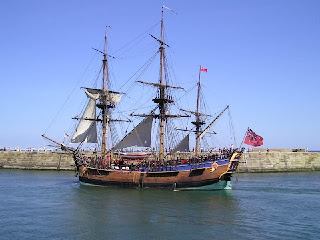James Cook rose from the ranks of ordinary working folk. The second son of James Cook, a Yorkshire labourer, and Grace his wife, he was born on the edge of the Cleveland Hills on February 27th, 1728, in the little village of Marton, which lies about four miles south-south-east of Middlesborough, and five miles west of the well-known hill and landmark, Roseberry Topping. Eight years later his father moved to Great Ayton, which lies close under Roseberry Topping.
At the age of thirteen Cook, who did have some elementary schooling both at Marton and Great Ayton, was apprenticed to one Sanderson, a draper and grocer of Staithes, a fishing village on the coast, about fourteen miles from Ayton and nine north-west of Whitby.
A year later Cook ran away to sea, shipping at Whitby on board the Freelove, a collier belonging to the Walker brothers.
In this hard school Cook learnt his sailoring. No better training could have been found for his future responsibilities. Here he learnt to endure the utmost rigours of the sea. Constant fighting with North Sea gales, bad food, and cramped accommodation, taught him to regard with the indifference that afterwards distinguished him, all the hardships that he had to encounter, and led him to endure and persevere where others, less determined or more easily daunted by difficulties, would have hurried on, and left their work incomplete.
All details of Cook's life during his thirteen years in the merchant service are lost: what voyages he made, how he fared, whether he advanced in general knowledge, all is gone. The only fact known is that in May 1755, when Cook was twenty-seven years of age, and mate of a vessel of Messrs. Walker, then in the Thames, he, to avoid the press, then active on account of the outbreak of the war with France, volunteered on board H.M.S. Eagle, of 60 guns, as an able seaman.
Captain Hugh Palliser, who succeeded to the command of this ship in October, was certainly Cook's warmest patron, and it would appear that Cook did work superior to that of an able seaman in the Eagle. All that is really known of this time in his life, is that that ship took her share of the fighting at the taking of Louisbourg and elsewhere on the North American and West Indian Station, and returned to England in 1759.
By Palliser's interest Cook was now appointed master of the Mercury. It is therefore evident that his qualifications as a navigator recommended themselves to Palliser.
The Mercury went to North America, and here Cook did his first good service recorded, namely, taking soundings in the St. Lawrence, to enable the fleet then attacking Quebec to take up safe positions in covering the army under Wolfe. This he accomplished with great skill, under many difficulties, in the face of the enemy, much of it being done at night. He was immediately employed in making a survey of the intricate channels of the river below Quebec, and for many years his chart was the guide for navigation. Cook was indeed a born surveyor. Before his day charts were of the crudest description, and he must have somehow acquired a considerable knowledge of trigonometry, and possessed an intuitive faculty for practically applying it, to enable him to originate, as it may truly be said he did, the art of modern marine surveying.
The expedition to Quebec concluded, Cook was appointed master of the Northumberland, bearing Admiral Lord Colville's flag, and during that ship's winter at Halifax he applied himself to further study of mathematics and astronomy.
In 1762, the Northumberland being at Newfoundland during the capture of that island from the French, Cook again was employed in surveys. This attracted the attention of Captain Graves, the Governor, who conceived a high opinion of his abilities in this respect.
In the latter part of 1762 Cook returned to England and married Elizabeth Batts, daughter of a man in business at Wapping; but a few months afterwards he was called upon by Captain Graves to go again to Newfoundland to make marine surveys.
In this important work he was engaged until 1767, Captain Palliser, who succeeded Captain Graves as Governor, being only too glad to avail himself of Cook's services. (Wharton 1893)








